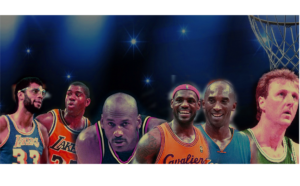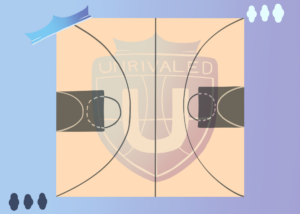As summer magazines showcasing celebrities in swimwear drift off the shelves, a hot new bombshell graces the covers lining check-out aisles. This one turns away from the normal actress “beach body” headline to spotlight a different A-lister: Los Angeles Lakers point guard Luka Dončić and his off-season fitness grind.
At the end of July, the newly ripped Dončić made headlines as the cover of Men’s Health magazine, raising questions once again about what athletes owe us with their bodies.
The corresponding article, by Andrew Heffernan and Ebenezer Samuel, references his notable biceps and slimmer physique, products of an intense workout regimen and improved nutrition after a tumultuous season. After suffering a sidelining calf injury in January amid murmurs that he was out of shape, Dončić was traded to the Lakers by the Dallas Mavericks. The trade came as a shock to all: Dončić and the Mavs reached the NBA Championship Finals in the 2024 season, Dončić was a fan-favorite franchise star, and the Mavs did not get a player of his caliber in return.
Lakers general manager Rob Pelinka even coaxed Mavs general manager Nico Harrison out of receiving first-round picks and other players by insinuating Dončić was a risk due to his weight and injury history. The trade, which happened overnight, came just a few weeks after Dončić finalized the purchase of a multimillion-dollar house in Dallas.
Following the Lakers’ early elimination from the NBA playoffs, the summer break came as a welcome way for Dončić to reset his game, complete with a short respite from basketball. After sitting on the injured list, dealing with the Mavs shipping him off, and hearing NBA fans commenting seemingly nonstop on his appearance, Dončić and his trainers team crafted a summer rebuild to start fresh this coming season.
He took off to his summer abode in Croatia, where weights and training equipment awaited him. His hard work paid off in a handful of ways—he reported better sleep and energy, enhanced athletic performance, and an even stronger discipline and growth mindset.
Still, the negative attention he received last spring, such as the article in Men’s Health about his “summer shred” and the ensuing media coverage, show that athletes’ bodies are still unfairly in public domain discussion.
Criticisms of Dončić’s pre-shred body had little-to-no historical basis. Dončić scored over 10,000 points in his six NBA seasons before turning 25 years old. He has the third-highest average regular season points-per-game in league history, trailing only NBA all-time greats Wilt Chamberlain and Michael Jordan. And while attitudes around weight loss and muscle gain take on an aesthetic tone in our society, fitness is much more than that.
Dončić’s functional training caters specifically to his strengths as a player, not his weaknesses as a supermodel. For example, while he is not known for his speed, he is capable of switching directions on a dime—referred to by the term “eccentric force.”
It’s this eccentric force, not top-line speed, that makes it possible for shooters to shake off defenders. So when he went to work out at the track, he would not do simple cardio: instead he practiced changing speeds and directions with resistance bands, according to the Men’s Health piece.
Even Dončić’s nutrition changes were not for crafting an Adonis-like body; his inclusion of anti-inflammatory foods, like nuts, berries, and leafy greens, boost post-game recovery, while high protein meals fuel top-level playing time.
Authors Heffernan and Samuel importantly included that athletes come in all shapes and sizes, despite stereotypes of athletic appearance. Every sport requires a different skill set, and as such, simply demanding buff or trim bodies is outdated. Bodies are flexible, but ultimately fragile, and are constrained by genetics.
Dončić’s critics got on his back after a couple of slow and struggling on-court sprints that seemed to dovetail with opinions on his body shape. What these critics did not seem to consider was that he had just come off a recovery period for his calf injury.
Just as with models or other celebrities, athletes’ role in the public sphere opens them up to unjustified and unqualified criticisms on appearance. In sports, function inherently tops form. But when apparent bodily“faults” coincide with bouts of mediocrity, the public intertwines the two mercilessly.
Female athletes know this all too well. At the 2024 Paris Olympics, multiple U.S. female athletes endured online comments mocking their wide shoulders and muscular backs. Olympic rugby player Ilona Maher and swimmer Katie Ledecky—the most decorated woman swimmer in Olympic history—received comments insulting their appearances for looking “manly.” Throughout her career, tennis star Serena Williams faced similar cruel comments. If we valued athletes for their bodies instead of their talents, strengths, or performances, so many of the astounding acts of coordination, grit, and determination that we love in sports would not exist.
However, as easy as it would be to say that body judgement has no place in sports, the matter is unfortunately not that simple. Team scouts searching for the next top talent continue to judge potential recruits based on body shape and athletic stereotypes. But athlete body judgement should not come from outside of the recruiting staff or professional trainers. And even within those roles, holistic evaluations cataloguing performance stats and player behavior should render simple body judgements obsolete and crude.
When fans mock their teams’ athletes, they hurt what they claim to love. Thoughtlessly cruel jokes about athletes’ bodies can get back to the athlete, harming both their performance and mental wellness. Fans invest so much time, money, and energy into sports that throwing unnecessary jabs at players is counterintuitive. Just remember: athletes are people too.





